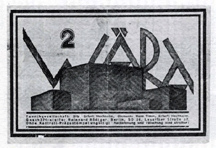
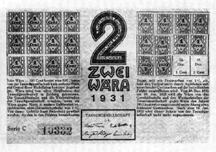
Local currencies have existed for millenia in different forms. The issuing of money has often been at least partly a political move as communities use the power of the mint to declare independence from their rulers, establish a group identity, and sometimes make a claim for political sovereignty. Such a situation was well-documented surrounding the Hasmonean revolts in Israel against Roman ruling authorities. By promoting remembrance of Israel's glorious history preceding the exile of its people to Babylon, shekels bearing inscriptions and symbols that pressured for a free Jewish state were minted in direct defiance of Rome's orders. Likewise, Continentals and Confederate dollars were two paper currencies printed by rebellious factions not only to finance their war efforts, but also to symbolically declare independence. To this day the creation of an alternative monetary system is seen as a subversive attack on the power and legitimacy of the ruling authorities It is interesting to note that most of the books on local currency are filed in the Library of Congress under anarchism.1
Silvio Gesell and Demurrage
In the years since the Civil War, the period of local currency's widest usage was during the Great Depression, when various currencies sprung up across North America and Europe. The stories of the scarcity of U.S. dollars are well-known, and where federal currency's departure created a void, human ingenuity stepped in. Forty years prior to the depression, a German businessman named Silvio Gesell had first proposed a redesign of the monetary system.2 Gesell was a follower of the Manchester school of economics, which proposed that the complete free reign of economic forces would cure everything. Gesell claimed the Manchester economists had accepted without reservation problems in the current monetary system, and proposed two principles of Free-Land and Free-Money to "eliminate the unsightly, disturbing, dangerous concomitants of the Manchester system."3 He believed that Free-Money would provide incentive for money to be used according to its purpose and function, which he believed to be as "an instrument of exchange and nothing else."4 His concern with ensuring that money would efficiently work to facilitate, cheapen, and speed the process of exchanging goods and services led to his interest in taxing holdings of money so as to spur men to engage in transactions.
Gesell's tax idea was based on a fee found first in Egyptian agricultural economics. Called demurrage, it was initially a tax on holding quantities of grain in storage. Around 1900 B.C., Joseph, also named Zaphenath-paneah, was the chief adviser to either King Amenemes or Senwosret during the Strong Middle Kingdom era, a period of great Egyptian prosperity in part due to Joseph's leadership.5 This Joseph initiated the construction of massive Egyptian storehouses to guard against times of famine. "Thus Joseph stored up grain in great abundance like the sand of the sea, until he stopped measuring, for it was beyond measure."6 In addition to being a cushion against shocks in the grain supply, the storehouses were used to keep grain in good condition from the time of harvest until it was needed by its depositors. These agricultural banks issued receipts identifying the quantity of grain deposited and the day on which the deposit was made. When the depositor wished to withdraw his grain, he presented his receipt and received the same quantity of grain, less a time-based charge to cover the costs of paying guards to oversee the storehouses, losses to rodents, and spoilage.
Gesell proposed that demurrage apply to currencies as well, arguing that money's currently-designed nature made it a commodity competing unequally with other commodities. Whereas other goods over time decrease in quantity and quality (with few exceptions like a fine wine, one supposes) and incur costs of storage, money diminishes not in value, but with banking, can even grow. "That being so, the answer to our question is clear, we must subject money to the loss to which goods are liable through the necessity of storage. Money is then no longer superior to goods; it makes no difference to anyone whether he possesses, or saves, money or goods. Money and goods are then perfect equivalents; Proudhon's problem is solved and the fetters that have prevented humanity from developing its full powers fall away."7 Hopefully either nations would redesign their currencies or communities desiring prosperity and physical wealth would print and promote scrip issues that incorporated this demurrage.
Originally Gesell suggested that money officially decrease in value by 5% a year, but he shortly replaced that idea with Swiss merchant George Nordmann's suggestion, called Stamped Free-Money. To discourage hoarding of money in place of goods, Nordmann suggested that a stamp tax be required at regular time intervals to maintain the scrip's status as current money.8 Unlike sales taxes which affect every transaction equally so as to discourage spending in favour of saving, the stamp tax would only have to be paid by the person in possession of the scrip at the end of each time period. Thus, the magnitude of the tax as a percentage of economic activity is inversely proportional to the number of transactions in a time period, and since the tax is not applied equally per transaction but only to the last man with the scrip, economic activity could theoretically become akin to a game of hot potato, resulting in a high velocity of money.
European Success Stories
Gesell's ideas found success in two European communities which had fallen on hard times. In the German town of Schwanenkirchen, the Depression led to the closure of a coal mine, the only industry in town. Two years afterwards, the mine owner heard about stamp scrip and, backed by a loan of Reichsmarks, reopened the mine by paying his workers in a scrip called Wara, named from the German words for goods and currency. Though this new money had a one percent monthly stamp tax, the miners agreed because the village shopkeepers were willing to accept Wara, since no other income source seemed likely.


Figure 1. Face, reverse of Two Wara note from Schwanenkirchen, Germany, 1932.
As The New Republic reported, "The shopkeepers then forced it on the wholesalers, the wholesalers forced it on the manufacturers, who in turn tried to pass it on to those who carried their notes, or they exchanged it at Herr Hebecker's mine for coal."9 The one percent monthly tax on scrip holdings made Wara quite successful as a general-use currency until the German Ministry of Finance decreed Wara illegal, at which point Hebecker closed his mine and the town returned to the government dole.10
In 1932 the Austrian town of Wörgl, facing almost total unemployment from the shuttering of most factories and a mounting inability to collect tax revenues, tried Wara with the help of a number of merchants and the local bank. Mayor Unterguggenberger paid town employees half in national currency and half in Wara with a one percent monthly stamp tax.
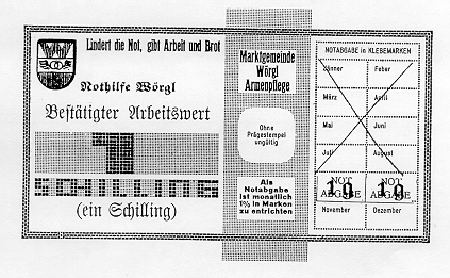
Figure 2. Face of one schilling note from Wörgl, Austria, 1932.
Though no records indicate whether the Wara faced hostile treatment or decreased acceptance as compared to the national currency on account of the tax, the results suggest it ultimately was fully accepted and served its purpose abundantly, so much so that when the townspeople ran out of things to buy, they paid their taxes in advance. Unterguggenberger initiated a number of public works projects with the income, repaving the streets, rebuilding the water system, and even constructing a bridge and a ski jump with the proceeds before the Austrian central bank pressured the government to outlaw it, probably from fear of its success spreading. According to the Heimat Museum in Wörgl, the average scrip note changed hands more than 400 times in the year and two months it was in circulation.11
Several factors likely aided Wara's acceptance in Woergl. Money was tight in general across Woergl; it was not merely one sector or small group affected, but a community collectively choosing to support it. Wara was fully supported by a small consortium of shopkeepers, which meant that though it was not the only currency in town, it was a substantial enough component of the available money that any merchant refusing to accept it could reasonably expect a sharp decline in business. Being accepted at par with national money for taxes and fees by the local government no doubt made indebted individuals and businessmen more willing to accept this strange paper.
American Depression Experiments
Stories of these short-lived European successes reached American shores and were especially well-received by followers of Gesell, including John Maynard Keynes and Yale economist Irving Fisher, who had read Gesell's ideas and become an advocate of stamp scrip. Fisher went so far as to author a book on the subject in which he wrote:
The chief objection to Stamp Scrip which I have thus far encountered is that it will not work because people will refuse it - it will not catch hold. But the man who said this, said later, "I guess I must be like the Englishman a hundred years ago, who said that the steam-locomotive couldn't work because smooth wheels could not catch on to smooth rails. While he was saying this in London, Stephenson was successfully running his locomotive in Scotland."12
Indeed, the Bureau of Foreign Affairs estimated that over 400 emergency currencies and scrip issues had sprung up as of February 1933, and this number saw a massive temporary increase with Franklin Delano Roosevelt's proclamation of a national bank holiday in March, the same timeframe in which Fisher's book was published. These general-use currencies took all sorts of names based on the location and the issuer, including depression scrip, trade stimulators, prosperity checks, clearing house certificates, tax anticipation notes, and school board warrants.13
Some issues of scrip did little to encourage the economic revitalisation of their respective communities, often due to poor issuance or poor design. In Chicago, newspaperman W. H. Caslow chose to pay his workers in Recovery Certificates.
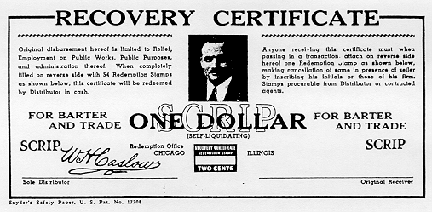
Figure 3. Face of one dollar Recovery Certificate from Chicago, Illinois, 1933.
These were intended to be a self-liquidating scrip through the affixation of a two-cent stamp at each transaction, and being redeemed for their face value and removed from circulation after fifty-four of these stamps were affixed. Rather than a tax on holding the currency as with Gesell's Wara, it was a sales tax. Greco postulates that Caslow's refusal to accept the Recovery Certificates as payment for advertising was the deciding factor in the scrip's failure.14 Though Caslow may have hindered circulation of the Recovery Certificates by issuing something he was unwilling to accept, advertising in a section is hardly a major necessity of life. Being forced to pay a 2% sales tax on transactions made in Recovery Certificates made Caslow's scrip a less-desirable medium of exchange than federal currency, besides which Caslow flooded the market with an estimated total of one million of these $1 certificates.15
In contrast to Caslow's program, the Independent Retail Merchants' Association of Evanston, Illinois issued scrip that was good only at the stores of its members, who paid the two-cent stamp tax per transaction, thus assessing these retailers in proportion to their perceived benefit from the program.16 This reduced their profit margins but may have driven enough business toward these stores to make up for the loss; data to answer that question is regrettably not available. Since this scrip did not require non-members to pay a stamp tax, it could circulate freely throughout the community backed by the goods of member retailers.
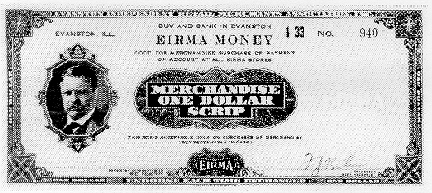
Figure 4. Face of Evanston Independent Retail Merchants' Association scrip, from Evanston, Illinois, January 1933.
On the other hand, when the city of Dover, Ohio, proposed a similar program, local retailers denounced it on grounds that the stamp tax would effectively make their profit margins negative, and the scrip was never issued.
Many local issues made headlines in regional newspapers, but what is lesser known is that the United States almost had a national, government-sanctioned issue of scrip. Iowa House of Representatives member Charles J. Zylstra had implemented a transaction-tax scrip in his hometown of Hawarden, which succeeded primarily from being one of the first issues nationwide. The Secretary of the Chamber of Commerce in nearby Mason City, Iowa wrote a harsh critique on stamp scrip, noting that Hawarden had "an exceptional group of business men, a good commercial club, and a municipal light plant" who "through the light plant and other city payrolls kept the scrip going till the few hundred dollars issued had been redeemed through stamps affixed."17
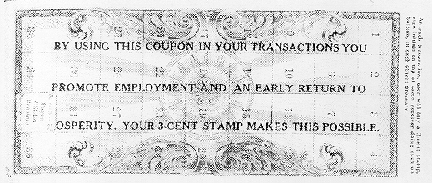
Figure 5. Reverse of one dollar scrip issue from Hawarden, Iowa, 1932.
As much as it claimed to boost employment and prosperity, its effects were not nearly so benevolent as its promoters wanted to think. Its users hated it, especially those members of the city payroll who saw the largest brunt of the tax by virtue of being paid heavily in it. As a small issue under uncommon circumstances, its success should not have been extrapolated to other communities or larger regions. Zylstra's public office led him to became a well-known advocate for a highly-flawed design, which he continued to stand for even after being counselled to the contrary by Fisher.
Fisher and other economists had been strongly in favour of Gesell's original conception, so much so that Fisher told Undersecretary of the Treasury Dean Acheson, "The correct application of stamp scrip would solve the Depression crisis in the US in three weeks!"18 (emphasis added) Part of Fisher's goal in that conversation may have been to achieve Treasury pressure against Zylstra's supporters to turn the tide in favour of a superior one, the Bankhead-Pettengill Bill. Introduced in both the House and the Senate in February 1933, it would have directed the Secretary of the Treasury to print $1,000 million in $1 stamped notes, to receive a 2-cent stamp weekly that would make the notes self-liquidating in a year.19 However, Acheson consulted with Harvard economics professor Russel Sprague who concluded that, were the program allowed to run its course, its likely success would be a political strike for decentralisation. Just a few weeks later, on March 4, 1933, Roosevelt announced a series of bold centralised initiatives known as the New Deal. At the same time he issued an executive decree prohibiting "emergency currencies," which effectively killed Bankhead-Pettengill.20 It took the outbreak of World War Two to fully restore the economy.
The Exeter Constant
With times of post-war prosperity, the impetus for the circulation of local currencies ceased for several decades. In 1973, an economist named Ralph Borsodi devised a currency in Exeter, Massachusetts. Called the Constant, he planned to protect it against inflation by backing it with a market basket of thirty commodities, including 20,000 pounds of rice, 400 barrels of petroleum, and a short ton of cotton seed. Constants would be redeemed for dollars at a rate proportional to the value of the market basket against the dollar. Borsodi hoped his alternative currency would be free from devaluation and the idea was exciting enough to the surrounding community that up to $160,000 worth of Constants were circulating in general use throughout the region, not only in paper currency but in checking deposits at local banks as well.
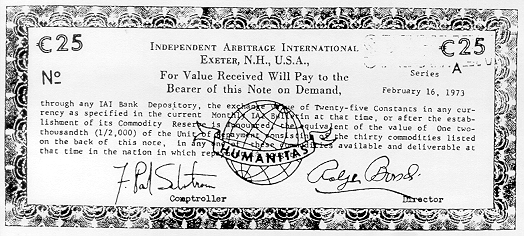
Figure 6. Face of Twenty-five Constants note from Exeter, Massachusetts, 1973.
Though he never got around to purchasing the commodities, the program ran, backed by dollars, for almost two years before Borsodi's health and old age caused the program to fold.21 Many years beforehand, Gesell had predicted the failure of such systems because, as he explained:
Money is not only a medium of exchange, but also a medium of saving, and money and potatoes, money and lime, money and cloth can never in any circumstances be looked upon as things of equal worth in the chests of the savers. A youth saving against old age will prefer a single gold coin to the contents of the largest warehouse.22
Gesell had hoped to spur men into adopting new monies that would be valued equally over time with potatoes, lime, or cloth, for he believed that as long as money did not depreciate, it would compete unequally with other commodities.
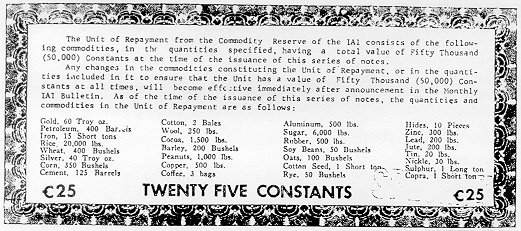
Figure 7. Reverse of Twenty-five Constants note, listing market basket of commodities by which the Constant was supposed to retain its value.
From the results of the Constant, one can note two things: first, popular trust in something can assign value by itself; no group launched a tirade against the program after learning that the commodities were never purchased, and second, even an ambitious project that saturates a region is likely to find its strength closely tied to the visibility and involvement of its leader. As one final comment, any currency activist who is irritated from an egalitarian perspective by the privilege the Federal Reserve possesses in printing federal currency should be equally wary of embracing any currency which is backed by metals or commodities, as such a money system will create by its inherent design a set of persons who are privileged brokers in the commodities or metals backing the currency.
Barter Revisited
Some individuals and communities have demonstrated a preference not to deal with alternative paper monies, but instead turning to barter in its various forms to facilitate exchange. For a successful barter exchange, two individuals must each simultaneously possess something the other individual desires. From an economic efficiency perspective, this represents a a reversion to a less-efficient mechanism suited better to days long gone. "But in these days when man's wants are more varied, such direct trades do not fit the varied supplies and demands of a complex social order,"23 wrote one Depression-era commentator. Irving Fisher went one step further, saying:
In the real life of the twentieth century, the handicaps to barter on a large scale are practically insurmountable. A desk maker, if he wants a ton of coal, would almost have to dump his desk in a hand-barrow and trundle it about till he met a coal dealer whose crying need happened to be a desk. Therefore [...] somebody organizes an Exchange Association, with a register in which are noted what can be supplied by whom and who wants what.24
If in 1933 barter could not run the nation, with the proliferation of variety in goods today, how much more difficult would success be? Barter still has a side role in many communities as my conversation with one California craftsman who exchanges hand-tooled leather goods for nights of a local innkeeper's services revealed:
It's just the idea that they now can trade for some Christmas gifts that they may not have the money for, and in exchange for that I get a room for a couple of nights for my folks when they come here. It's retail for retail. . . . I don't go into how they figure it out. I agree with whatever they say, and it's not outlandish, and they do the same with me.25
Even this exchange is not a pure barter trade, as dollar figures for valuation are considered, and it closer resembles a pair of bar tabs than barter, unless barter is redefined to include multi-period activities. "I have trades going back for fifteen years. We've never been even."26 By keeping the transactions extremely simple, barter can accomplish occasional success, but even the suggestion of an Exchange Association, which is one form of complex barter, would require extensive market coordination.27 Fisher makes here two points: first, barter will not be the solution to our problems in any but rare occasions, and second, there is an information deficit that must be addressed for multi-party trade arrangements to succeed. A system of value exchange other than simple barter breaks down the resolution of this information deficit into smaller pieces. No man need determine all the exchanges that will happen, merely those in which he is involved.
As technology has developed, methods of exchanging value in barter-like settings have advanced as well. In addition to fiat currencies, wherein value is created by assignment of an authority, there are mutual credit currencies, which are "created by the participants themselves in a transaction as a simultaneous debit and credit."28 Though this concept has been around for quite some time in the form of babysitting co-operatives, the advent of computers has permitted a massive streamlining and enhancement of the bookkeeping process necessary for a mutual credit currency to grow beyond thirty or so persons. Two programs are most often cited when discussing mutual credit currencies, LETS and Time Dollars.
The Local Employment and Trading System (LETS) was first designed by Canadian Michael Linton in the early 1980s. Often quoted as saying, "Money is really nothing but information," he organized a non-profit association to function as a clearinghouse and information service to facilitate exchange between members.
Members begin with a zero balance and in the course of transacting, some will become negative, which is permitted since, unlike at a bank, it is the members who issue their own money supply through a process known as mutual credit. Designed to overcome the difficulties of multi-party barter and skills exchanges, LETS normally tracks members' accounts via computer software, which has made LETS the most-studied of currently-operational alternative currencies on account of the ease of accessing transaction records. A small annual membership fee compensates the record-keepers. The bookkeeping element in LETS makes the unit of exchange essentially a community IOU, a promise for repayment in services or goods at a future date. Aside from the greater likelihood of haggling over prices and decisions by various national governments to exempt these exchanges from taxation, this perfectly resembles commercial transactions on Main Street. This cost of haggling may be negated by other factors though, as John Stein, a former LETS co-ordinator with a doctorate in Economics from the University of Chicago commented. "LETS puts a negative transaction cost or a positive benefit on the transaction. You actually build community and get a community satisfaction with each transaction. You’ve bonded with others."29 The exact calculation of the transaction cost must be performed by each individual, based on the value that they associate with building community, but it can be reasonably said that for at least some persons the use of LETS as a medium of exchange is either less costly or more beneficial than federal currency at the margin since they choose to engage in transactions using LETS.
How exactly a currency can be a transmitter of information about worth without ever having had any real worth associated to the currency itself is unclear, and it seems that such a program would never have begun upon its own but only succeeds by clinging, remora-like, to men's understanding of the dominant exchange economy and making little sculpted modifications. LETS also is not nearly as self-managing as a paper currency system, requiring a central office to which members call to report transactions. The expense to administer a LETS and the inability to trade with individuals who have not signed up with the system are two further disadvantages of a LETS compared to a paper currency, making LETS possibly a restricted-use currency. Nonetheless, local currency programs today are predominantly following the LETS model: over 500 LETS are currently operational, with the vast majority located in Australia, New Zealand, and the United Kingdom.30 Unlike a scrip issue, a member could possibly leave the community with a negative balance; this risk of default is not present in paper currency, and has become a concern in some circles as individuals with consistently negative balances depart, leaving the system with unusable credit. This risk is balanced by the opportunity for the community to institute self-policing by viewing the transactions records of their fellow members and granting greater credit to those with a history of active involvement than to those deemed leeches.31 A scrip issue never has these concerns; one's interest is in the soundness of the paper much more than the person providing that paper.
Another program named when mutual credit currencies are discussed is Edgar Cahn's Time Dollars. Using a similar computerised process for recording transactions, it focuses on rewarding people for the sorts of activities that neighbours used to do for one another free of charge. It is clearly a restricted-use currency, being accepted normally only for services and not goods. Cahn conceived the idea while recovering from a heart attack, saying, "Dollars value what is scarce. I hope these things are never in such short supply that they become valuable in the market economy."32 Earned at one Time Dollar per hour, some communities have generous benefactors who have agreed to redeem these for goods and services as a way of attempting to personally place value upon these acts of caring and service. The best-known example is from one neighbourhood in Washington, D.C. which received $230,000 in legal work to get rid of a crack house and keep a school open. That work was donated by a major law firm after residents logged many hours of community improvement, from street clean-up to an escort service to ensure the safety of community members. One challenge in implementing a time dollar bank remains the expense. It has been estimated that the start-up costs alone are a minimum of $50,000 for an office, a computer and office supplies, an employee to record the transactions, and other miscellaneous expenses.33
One odd element about programs like Time Dollars is that even as they present themselves as non-monetary systems to provide for the needs of community members, they can conceivably encourage greater dependence upon market exchange systems. Individuals might choose to earn Time Dollars rather than perform services as favours for neighbours and friends, valuing Time Dollar earnings over the reputational capital that comes with friendship and service. Marketplace allocation schemes may not be preferable to gift exchange in this instance from a community well-being perspective, because the mere offering of Time Dollars for services may lead individuals to choose away from providing services to individuals from whom they would not expect future reciprocity, such as invalids and elder citizens. If all members expect to redeem the Time Dollars they have earned, the system may collapse when it becomes clear that some of the debtors in the system, the least fortunate of the society, will be unable to repay their debt, leaving someone giving something for nothing whatever way you look at it. The very mention of earning anything may induce potential providers of free services to change focus to earning Time Dollars, when the goal of program co-ordinators is solely to draw out those who were not previously public servants. From a rational redemption viewpoint as previously explained, this switch may be implausible, but it is not above man's nature to choose activities from which he can gain bragging rights, and the ability to measure one's volunteerism might be valued by the less-genteel of society.
Ultimately, I am not of the opinion that Time Dollars should be considered a currency or mentioned in discussions of alternative monetary systems owing to one simple fact: 85% of Time Dollars earned are never spent.34 The program may be assisting those in need, and may be forming connections between persons in ways that would not have occurred through traditional neighbourhood associations or charity organisations. It may be a non-traditional market facilitating exchange. But even if it could be shown that the earning of Time Dollars was the direct motivation behind every transaction, the fact that these earnings are so often left unredeemed means that it would be difficult to assert that the individuals providing the services ever intended anything but altruism. Even Cahn agrees that Time Dollars are not real money, but only a record of services. The IRS ruled accordingly that service credits are non-taxable.35 The future success of Time Dollar programs depends upon funding from altruistic sources.
NORFED: Competition is Good
Many of these currencies have called themselves "complementary" in one publication or another, declaring that they do not wish to replace federal currency but merely buttress it and add to the wealth of community members. One recent currency, however, has as its stated purpose to bring "competition to America's most basic monetary unit, its currency,"36 and is backed by silver. Called the American Liberty Dollar (ALD), every ten dollars worth of this currency is backed by one ounce of silver, which last traded for ten dollars per ounce in 1987. Persons agreeing to serve as redemption centres and exchange federal currency for ALDs receive a five percent discount on the purchase of ALDs from their distributor and promoter, Bernard von NotHaus.
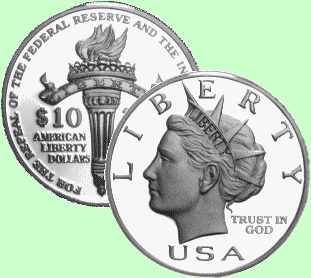
Figure 8. Face, reverse of NORFED ten dollar coin, "The Silver Liberty," 2000.
Despite having distributed over $200,000 of currency, three times the currency of Ithaca, NORFED's program is unlikely to succeed. Because the currency is distributed nationwide and is currently redeemable at less than 130 businesses in the United States and Canada including a kayak rental company, an alternative energy firm, and a Ferrari service shop, the currency is best considered a novelty money-maker for von NotHaus rather than a unit of exchange. A restricted-use currency, anecdotal tales of its acceptance everywhere from its various promoters are not likely to be repeated by the recipients of this currency unless they too become quite enthusiasic and educated about the product, which could constitute a major investment on their part for uncertain returns.37
Being backed by silver instead of the Exeter Constant's 30 commodities makes ALDs easier to understand and promote to potential recipients, some of whom may resent the fact that federal currency has ceased to be backed by precious metals. Since the program, unlike the Exeter Constant, is not saturating a region either from a financial or media information standpoint, the possibility of ALD recipients coming in contact with the currency from more than one party is unlikely. Though von NotHaus states that the currency will prove to be a successful store of value upon the collapse of the U.S. dollar, its current value seems to be primarily a way of slightly reducing the cost of living for the ALD's active promoters from their discount on the purchase of ALDs. It will need to gain wide acceptance across a community before it can claim to possess value outside of its convertability to silver, a process which currently discounts the currency's value by over 50%.38
Discount Scrip: Deli Dollars and Farm Preserve Notes
In contrast to American Liberty Dollars which charge a hefty discount should the currency ever be redeemed for the commodity backing it, several currencies in the Berkshires region of western Massachusetts have succeeded by offering a discount upon purchase of the currency, with the stipulation that the notes cannot be redeemed immediately. The first version was implemented in 1989 by Frank Tortoriello, who sought to relocate his restaurant after his lease expired. Denied a bank loan, he printed his own "Deli Dollars," coupons redeemable at his restaurant six months later for $10 worth of food, which he sold to his customers for $9 each. Though intended as a one-time short-term loan instead of as a currency, the media surrounded it excitedly after it began circulating through the community, appearing in such locations as the bookstore and the First Congregational Church's offering basket.
The E. F. Schumacher Society, which had suggested to Tortoriello this endeavour, encouraged and educated others in this process. Berkshire Farm Preserve Notes, with a cabbage head in place of a presidential portrait and the inscription "In Farms We Trust," were first issued in 1990 to help two area farms get through the winter without a loan from the bank. The Monterey General Store and Kintaro restaurant issued notes based on the same model. These assorted local currencies have shown up in cash drawers around the region, apparently accepted at face value immediately despite the discount on their initial sale. Perhaps the creation and usage of a schedule of appreciation during which the notes would increase in value from their issue price of $9 to their redemption price of $10 would require more expended effort than would be worthwhile given the magnitude of the issue. With these and other scrip issues becoming a more common element of the Berkshires economy, plans are in place to implement a community-wide local currency.39
With historical developments in alternative monies hereby simply delineated, one major program of current importance remains for discussion and a much closer examination, the Ithaca HOURs program and the currency issues it has spawned. A locally-issued non-profit fiat currency, its historical development and detailed economic design will be dealt with in the next chapter.
| Contents | Previous Chapter | Next Chapter |
Endnotes:
1 Susan DeWitt, Local Currencies: Theory & Practice
(TUC* Radio C402, 1998) Cassette.
2 In 1891, Gesell wrote Currency Reform as a Bridge to the Social State, the first exposition of his concept of non-hoardable money.
3 Silvio Gesell, The Natural Economic Order, trans. Philip Pye (London: Peter Owen, 1958), 15.
5 Ron Ritchie, God is not Mocked. #4420 (Palo Alto,
Calif.: Discovery Publishing, 1995).
8 Philip Pye, "Methods of Applying the Principle of Free-Money," in The Natural Economic Order (London: Peter Owen, 1958), 445.
9 Hans L. Cohrssen, "Wara," The New Republic, August 10, 1932.
10 Irving Fisher, Stamp Scrip (New York: Adelphi, 1933), 19; Thomas H. Greco, Jr., New Money for Healthy Communities (Tucson, Ariz.: Thomas H. Greco, 1994), 58-59.
11 Greco, 60; Bernard Lietaer, The Future of Money (London: Random House, 2001), 153-155.
13 Ralph A. Mitchell and Neil Shafer, Standard Catalog of Depression Scrip of the United States (Iola, Wisc.: Krause, 1984), 13, 16.
16 L. H. Grinstead and Willis Wissler, Barter Scrip and
Production Units as Self-Help Devices in Times of Depression (Columbus,
Ohio: Bureau of Business Research, 1933), 28.
17 Lester Milligan, "The Stamp Scrip Experience of Mason
City, Iowa," in Mitchell and Shafer, 311-312.
18 Fritz Schwartz, Das Experiment von Woergl (Bern:
Genossenschaft Verlag Freiwirtschaftlicher Schriften, 1951), 14.
20 Bernard Lietaer, "A Strategy for a Convertible Currency,"
ICIS Forum, Vol. 20, No. 3, 63.
21 Greco, 67; Dave Block, "Local Money Strengthens Communities," In Business, July/August 1998, 13.
23 Wayne Weishaar and Wayne W. Parrish, Men Without Money: The Challenge of Barter and Scrip (New York: Putnam, 1933), 6.
25 Edward P. O'Brien, interview by author, 17 July 2000,
Mendocino, Calif. (Tape recording).
27 Complex barter is an exchange between three or more persons, where A has what B wants, B has what C wants, and A ponders what he wants from C to complete the transaction.
28 Lietaer, The Future of Money, 160.
29 John Stein, interview by author, 6 December 2000. (Transcript).
30 Greco, New Money, 88-95; Michael Linton, Frequently Asked Questions about LETSystems (21 April 1996). Available [Online]: <http://www.gmlets.u-net.com/faq.html> [5 March 2001].
31 Jorim Schraven, "The Economics of Local Exchange and Trading Systems: A Theoretical Perspective," International Journal of Community Currency Research 4 (2000). Available [Online]: <http://www.geog.le.ac.uk/ijccr/volume4/4no5.htm> [7 November 2000].; Howard Rheingold, The Internet and the Future of Money (April 1997). Available [Online]: <http://www.transaction.net/press/tomorrow.html> [10 September 2000].
32 Edgar Cahn, in David Boyle, Funny Money: In Search
of Alternative Cash (London: HarperCollins, 2000), 11.
36 NORFED, NORFED -- National Organization for the Repeal
of the Federal Reserve Act (1999). Available [Online]: <http://www.norfed.com>
[19 February 2001].
38 The New York Mercantile spot price for silver as of April
10, 2001 was $4.31 per troy ounce.
39 Michael Specter, "Capitalizing on Yankee Ingenuity,"
Washington Post, 20 May 1991, A1; Susan Witt, "Printing Money, Making
Change," Orion Afield, Autumn 1998, 19. Witt says the Deli Dollars
were sold for eight dollars each; all other sources mentioning Deli Dollars
even in passing report the price as nine dollars.